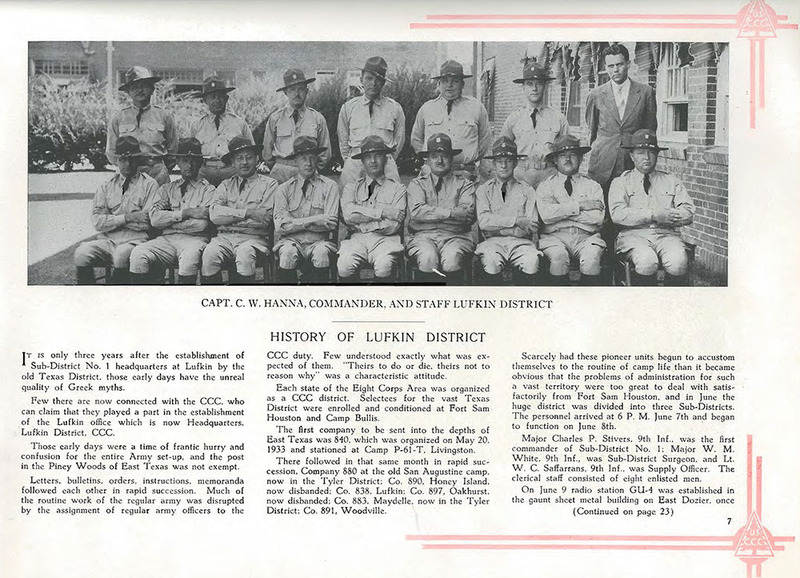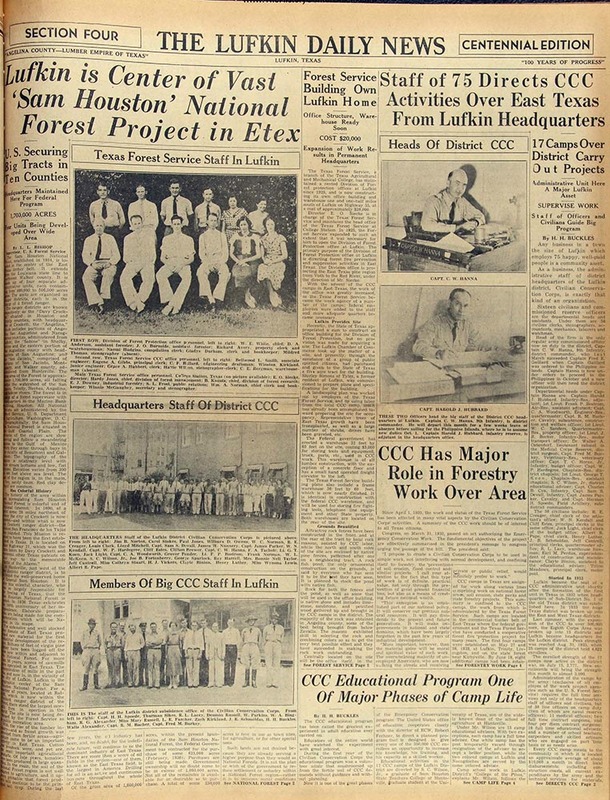Civilian Conservation Corps Camp and District Headquarters - Lufkin, Texas

Established in 1882, the town of Lufkin grew up amidst a regional timber boom that shaped East Texas. During the late nineteenth century, as national population growth and industrial development exhausted the few remaining hardwood forests in the northeastern United States, a growing demand for southern lumber and other timber products helped drive a surging business in trees. With a rail stop on the Houston East and West Texas Railroad, Lufkin soon emerged as an important hub for the timber trade. Local forests thus played a major role in the founding of Lufkin and have helped to shape the city ever since.
During the Great Depression of the 1930s, federal officials with the Franklin D. Roosevelt administration selected Lufkin as the site for a large Civilian Conservation Corps (CCC) camp that operated from 1933 to 1942. Working in association with the Texas Forest Service (TFS), the Lufkin CCC camp used progressive forestry techniques to help the East Texas forest industry. The TFS also made Lufkin the District Headquarters over many East Texas CCC camps. The district offices were located in an educational building rented from the First Christian Church located behind Hotel Angelina on Shepherd Avenue. The building is now an antiques store.
By the end of 1933, the Lufkin District was in charge of seventeen CCC camps. Some CCC camps disbanded or moved to new districts, but all of these camps were, at one time or another, under the Lufkin District: Ratcliff, Nancy, Jasper, Beaumont, Woodville, Livingston, Huntsville, Kennard, Groveton, Madisonville, Trinity, Apple Springs, Lufkin, Nacogdoches, San Augustine, Coldspring, Honey Island, Oakhurst, and Maydelle. The CCC camps of the Lufkin District employed thousands of young men during the Great Depression, paying them $30 a month, and helped over nine years of operation to make East Texas what it is today.
The men in Lufkin District camps spent their days building fire towers, bridges, culverts, and roads in order to access remote parts of the forest. These men also strung up telephone lines, planted trees, and fought forest fires. The CCC fed these men well; the Lufkin District found that new enrollees gained an average of almost four pounds in their first five weeks. The CCC camps purchased food from local ranchers, which in turn helped the local economies. Each of the Lufkin District’s camps pumped an estimated $10,000 monthly into their local communities.
The CCC abandoned the Lufkin camp in 1942, the same year that the United States government began building Prisoner of War (POW) camps for captured prisoners taken in World War II. Lufkin was home to two such POW camps. In November 1943, Southland Paper Mills leased the old CCC camp as a POW labor camp, and 300 German prisoners held there salvaged lumber and produced pulpwood for Southland Paper until 1946.
In 2008, the state of Texas erected a historical marker at the site of the former CCC Lufkin District heavy equipment maintenance facility on current day Raguet Street. The marker notes that the Lufkin camp not only proved to be instrumental in relieving unemployment in East Texas but also "contributed greatly to forest conservation in Texas."
Audio
Images











